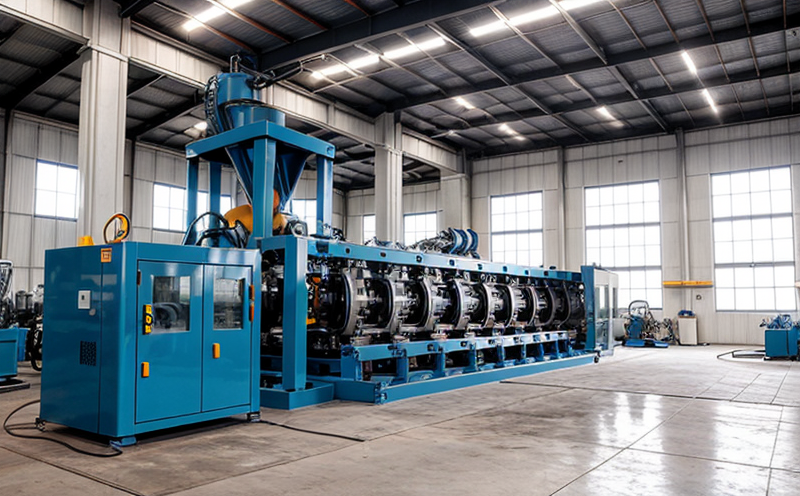ASTM G85 Corrosion Performance Testing of Machinery
The ASTM G85 corrosion performance testing standard is a critical tool in ensuring the durability and reliability of machinery across various industrial sectors. This test evaluates the resistance of metallic materials to atmospheric corrosion, particularly focusing on the effects of chloride-containing atmospheres such as those found near coastlines or in regions with high humidity levels. The test methodology involves exposing specimens to a salt spray atmosphere for extended periods under controlled conditions.
Understanding the importance of this testing is crucial for quality managers and compliance officers who aim to maintain product integrity and meet regulatory standards. R&D engineers can leverage this information to refine design processes, while procurement teams ensure that they are selecting materials capable of withstanding harsh environmental conditions.
The ASTM G85 test provides a standardized approach to measuring the corrosion resistance of metal parts used in machinery. This standard is widely recognized for its accuracy and repeatability, making it an essential tool in ensuring consistent quality across manufacturing processes. The test involves several steps: preparation of the specimen, exposure to the salt spray environment, monitoring, and evaluation.
Specimen preparation typically includes cleaning and drying the metal parts according to ASTM G85 specifications. Once prepared, the specimens are placed in a controlled environment where they undergo continuous exposure to a chloride-containing atmosphere. This process simulates real-world conditions that machinery might encounter over its operational life. The duration of this exposure can vary depending on the specific requirements of the product being tested.
Monitoring during the test is critical as it allows for close observation of any signs of corrosion, such as pitting or rust formation. After the specified period has elapsed, the specimens are removed from the environment and inspected according to ASTM G85 guidelines. These inspections can reveal the extent of corrosion damage, providing valuable data for quality assurance teams.
The results of these tests play a significant role in determining the suitability of materials for use in specific applications. Engineers can use this information to make informed decisions about material choices, leading to more durable and reliable machinery. Compliance officers benefit from having reliable test results that help ensure products meet necessary regulatory standards.
By adhering to ASTM G85, manufacturers can enhance their reputation by demonstrating a commitment to quality and reliability. This not only enhances customer confidence but also contributes positively to brand image. Furthermore, compliance with international standards like ASTM G85 fosters trust among stakeholders, including investors and regulators.
- Ensures consistent product performance across different environmental conditions
- Simplifies regulatory compliance through internationally recognized testing methods
- Reduces risks associated with material failure in critical applications
- Promotes innovation by providing reliable data for new design iterations
In conclusion, ASTM G85 corrosion performance testing is a vital component of any comprehensive quality management strategy. It provides valuable insights into how materials will behave under specific environmental stresses, helping to ensure that machinery remains functional and safe throughout its operational lifecycle.
Quality and Reliability Assurance
The ASTM G85 corrosion performance testing process is designed to provide robust quality assurance measures. By subjecting specimens to controlled atmospheric conditions, this test helps identify potential weaknesses in material selection or design that could lead to premature failure under real-world usage scenarios.
- Identifying Potential Weaknesses: One of the primary benefits of ASTM G85 testing lies in its ability to highlight any inherent flaws within a metal part's composition. Through continuous exposure to chloride-containing atmospheres, subtle issues such as impurities or inconsistencies may become apparent.
- Predicting Real-World Performance: Another key advantage is the capacity for predicting long-term performance based on short-term tests. The data obtained from ASTM G85 can be used by engineers and designers to anticipate how a particular component will behave in various environments over time.
- Enhancing Durability: By identifying problematic areas early in the development process, manufacturers can implement corrective actions before issues escalate into more significant problems. This proactive approach enhances overall product durability, reducing maintenance costs and extending service life.
The results of ASTM G85 testing are essential for maintaining high standards of quality assurance throughout production cycles. They serve as a benchmark against which all other aspects of manufacturing can be measured. Additionally, these tests contribute significantly to enhancing the reliability of machinery by ensuring that only robust materials are used in critical applications.
International Acceptance and Recognition
The ASTM G85 corrosion performance testing standard enjoys widespread acceptance across numerous industries worldwide due to its rigorous methodology and consistent results. Many countries have adopted this standard as part of their national regulations governing the manufacture and use of corrosion-resistant materials.
Incorporating ASTM G85 into international standards ensures that manufacturers adhere to globally recognized benchmarks, thereby facilitating trade between nations without compromising safety or efficacy. For instance, organizations involved in exporting products must comply with these internationally accepted criteria to ensure they meet buyer expectations abroad.
The universality of ASTM G85 also promotes collaboration among professionals from different regions who share common goals regarding material science and engineering practices. This collaborative environment fosters knowledge exchange and innovation across borders, contributing to advancements within the field.
Competitive Advantage and Market Impact
The ability to demonstrate compliance with ASTM G85 corrosion performance testing can provide a significant competitive edge for manufacturers seeking to differentiate themselves in the marketplace. In an increasingly globalized market, adhering to internationally recognized standards such as these demonstrates commitment to excellence and reliability.
By showcasing their adherence to rigorous quality assurance measures like those prescribed by ASTM G85, companies signal to potential customers that they prioritize product integrity above all else. This focus on quality can attract buyers looking for dependable solutions capable of withstanding challenging operating conditions successfully.
In addition to enhancing brand reputation and attracting customers, compliance with international standards also opens up new market opportunities. Companies that have already proven their capability to meet such stringent requirements may find easier access into foreign markets where local regulations mandate similar testing protocols.





